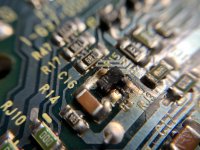elemenoh
Well-known member
I've been trying to restore a floppy drive from an SE. The usual stuff like cleaning, replacing grease and replacing the bad eject gear went fine. It would still not read or format disks.
I've tried adjusting the track 0 sensor and stator motor across their range, but haven't seen any improvement.
Disks will begin to format but ultimately fail. There's a noise about 30 seconds in, just before the failure where it sounds like something is rubbing.
Should I keep tinkering with track 0 and/or stator? Anything else to try? Or does this just seem like it has a bad head and I should move on?
View attachment Bad floppy.m4a
I've tried adjusting the track 0 sensor and stator motor across their range, but haven't seen any improvement.
Disks will begin to format but ultimately fail. There's a noise about 30 seconds in, just before the failure where it sounds like something is rubbing.
Should I keep tinkering with track 0 and/or stator? Anything else to try? Or does this just seem like it has a bad head and I should move on?
View attachment Bad floppy.m4a

